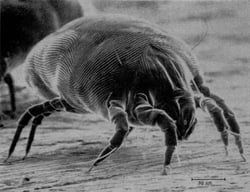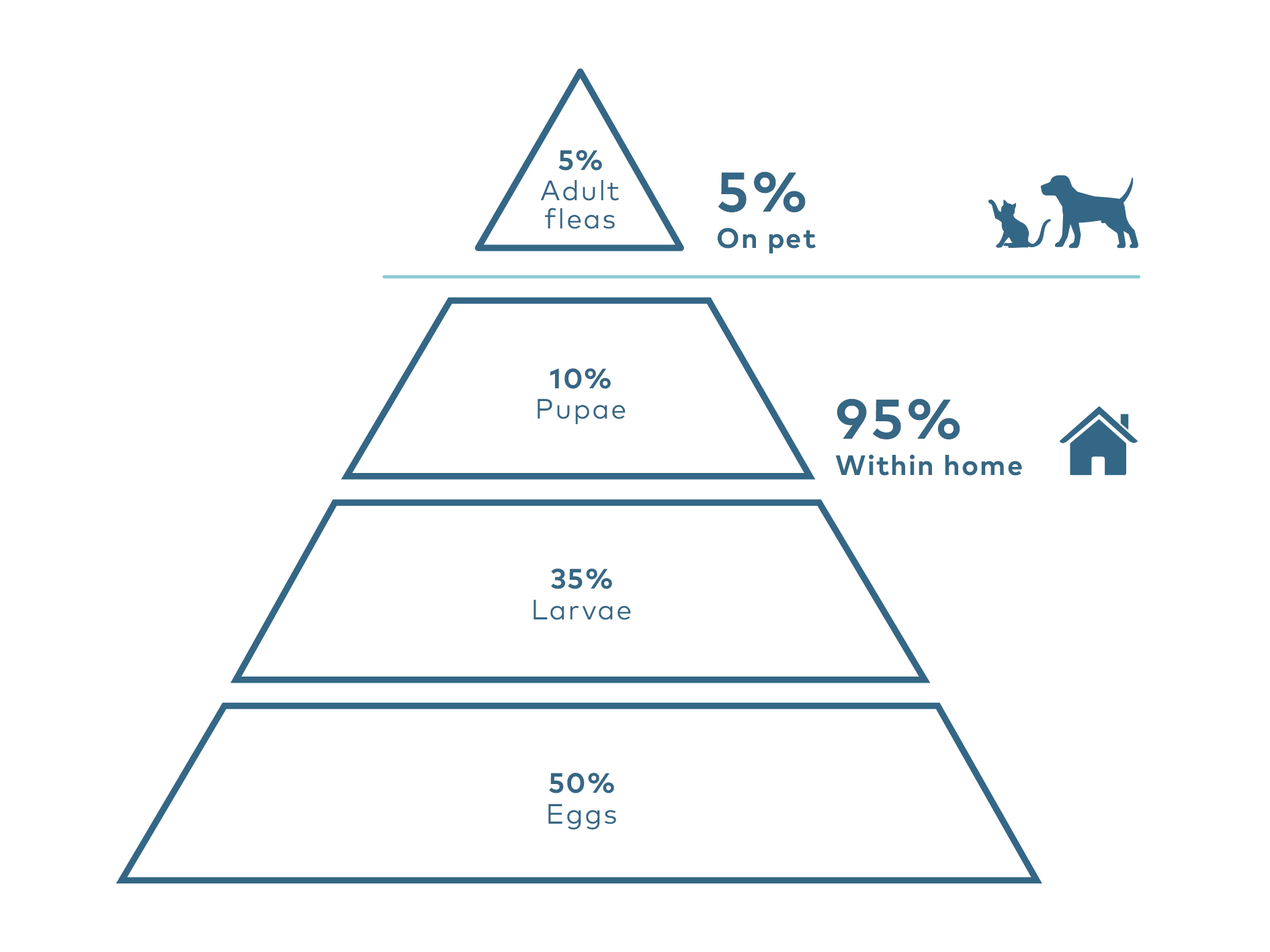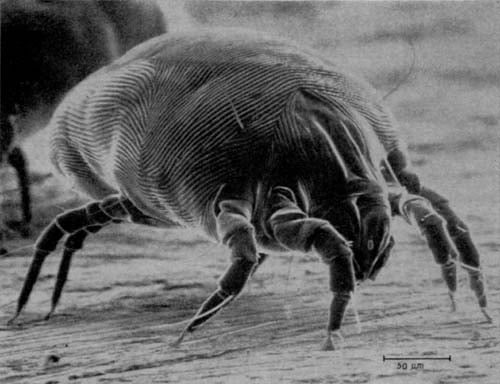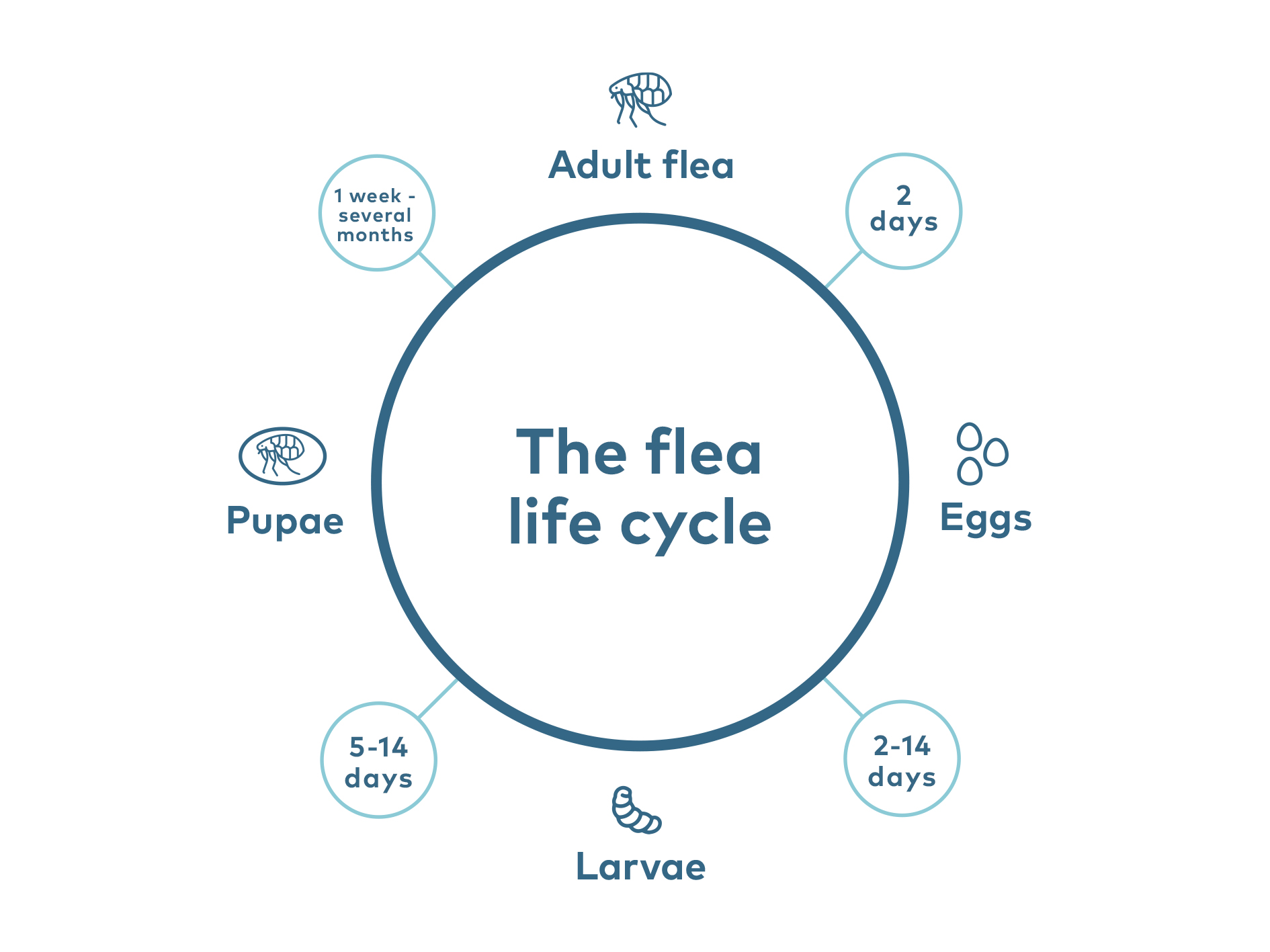When environmental allergy is mentioned, often pollen is the first thing that springs to
mind (no pun intended!). You visualise someone suffering from the classic hay fever symptoms during spring or summer; itchy eyes, sneezing and a runny nose, after exposure to whichever tree or plant is their trigger. However, it’s not just outdoor allergens that cause issues for our pets, indoor allergens are actually remarkably common in dogs and cats and can cause serious skin and respiratory problems all year round. Below we discuss the top 5 allergens found indoors and provide practical tips on how to reduce your pet’s exposure to them.
1. House dust mites
These mites are very small and almost transparent
 arachnids (mites have 8-legs like spiders). They eat
dead skin flakes from both humans and pets. It is the dust mite droppings and dead body parts, rather than the live dust mites themselves, that provoke an allergic reaction when they are either inhaled or touched. The mites live in bedding, upholstered furniture, carpets, curtains, mattresses and pillows. An estimated 100,000 - 10 million mites live in a typical used mattress and 10% of the weight of a two-year old pillow is supposedly made up of dead mites and their droppings!
arachnids (mites have 8-legs like spiders). They eat
dead skin flakes from both humans and pets. It is the dust mite droppings and dead body parts, rather than the live dust mites themselves, that provoke an allergic reaction when they are either inhaled or touched. The mites live in bedding, upholstered furniture, carpets, curtains, mattresses and pillows. An estimated 100,000 - 10 million mites live in a typical used mattress and 10% of the weight of a two-year old pillow is supposedly made up of dead mites and their droppings!
How can I reduce my pet’s exposure to dust mites?
Unfortunately, removing dust mites completely from the home environment is impossible, but there are ways that you can reduce their presence such as:
- Vacuuming or dry-cleaning your carpets, curtains and upholstery regularly.
- Turning down the central heating (they thrive in warm temperatures).
- Washing your pet’s bedding and stuffed toys regularly at hot temperatures or
freezing them, e.g. freeze the soft toy for 24hrs to kill the mites then wash to
remove the body parts. - Not allowing your pet to sleep in your bedroom as this is the dust mite hotspot
in the home.
2. Storage mites
Where do storage mites live and how can I reduce them?
Storage mites are tiny and white, they feed on stored foods such as flour, grain and seeds. They are also often found in poorly stored dry complete pet diets, so good management of your pet’s food can greatly reduce their exposure to storage mites. When using dry foods we would recommend:
- Placing the feed, in its bag, into resealable plastic containers to help prevent storage
mites getting into the feed. - Cleaning these plastic storage containers regularly (and always before adding any new food), discarding any dust at the bottom.
- Keeping the food in dry, cool conditions.
- Purchasing only small bags of food rather than large bulk packs to ensure
fresher batches are fed. - Wiping your pet’s face with a damp cloth after it has finished feeding to
remove any food residue. - Cleaning your pet’s food bowl daily
- Feeding wet/tinned foods or a home prepared diet instead of dry food
(discuss this with your vet if your pet is on a specialised diet or has been
recommended dry food, any long-term home prepared diet will need to
be nutritionally balanced). - Ensuring the food is within its use-by date.
3. MOULDS
Moulds are a type of fungus and they like warm, damp and humid conditions best.
They spread by producing tiny spores which are too small to see but float through
the air. When these spores are inhaled or touched, they can cause both irritation
and allergic reactions. This results in similar symptoms to hay fever; itchy eyes,
sneezing, runny nose or sometimes a skin rash. To reduce the amount of mould in
your home it’s important to make the environment difficult for mould to live in by
reducing the dampness.
| Where you find moulds indoors | How to reduce moulds indoors |
| Carpets/textiles | Keep bathrooms and areas where the laundry is done well ventilated |
| House dust | Don’t dry clothes indoors (line-dry and tumble dry instead or use a room not accessible to your pet) |
| Behind paint or wallpaper | Treat any damp walls with a mould inhibitor |
| Water damaged buildings | Keep all pet beds, coats etc. in a dry environment |
| Moist chipboard | Check food sources for signs of mould or rot, especially on fruit and vegetables |
| Window frames | |
| Stored grain/cereals | |
| Fruit and foods | |
| Leather items | |
| Wool/cotton |
| Where you find moulds outdoors | How to reduce moulds outdoors |
| Soil | Avoid heavy vegetation around or over the house (e.g. ivy and other climbing plants) |
| Forage (e.g. hay) | Keep the garden free of fallen leaves and other garden debris |
| Decaying plant debris (compost heap) | Ensure the compost heap is well covered and your pet does not have access to it (also important as eating mould contaminated food can be extremely dangerous to pets) |
4. Fleas
Why is it important to control fleas?
Fleas are a major insect pest to our pets.

Not only do they cause discomfort by biting, but they can also transmit disease. Some animals have a heightened response to flea bites (known as flea allergic dermatitis), which means they have an allergic response to the flea saliva. In this situation, rather than it just causing the usual irritation and inflammation even a few flea bites can trigger extremely itchy and irritated skin. Once fleas are in the home, it can be a lengthy process to eradicate them.
The aim of flea control (treatment) is to eliminate the adult flea as well as all the other
stages of the life cycle (eggs, larvae & pupae). Female fleas can lay up to 50 eggs
every day meaning that for every live flea seen on your pet, there will lots more eggs
waiting to hatch in your home. You may be shocked to learn that the fleas you find
on your pet represent just 5% of the problem and that the other 95% is actually within
your home!
All control measures used for house dust mites also apply to fleas and daily
vacuuming is particularly important. There are also a number of flea preparations
that can be given to/used on your pet and also for the environment. Your veterinary
surgeon will be able to advise on the most appropriate preparations for you.

5. DANDER (CAT EPITHELIA)
What can I do to help reduce my dog’s exposure to cat dander?
It’s not only people that have allergies to cats, some dogs do too! The allergy is caused by a protein present in the tiny flakes of dead skin (dander) and the cat’s saliva, which sticks to the fur when the cat grooms itself.
We recommend the following measures to help reduce your dog’s exposure to cat dander:
- Grooming your cat at least once a week, either outside or in a well-ventilated
room away from the dog. - Washing your pet’s bedding once a week.
- Washing your hands in between handling your cat and the dog.
- You could discuss with you vet whether a new type of cat food, which
reduces the amount of allergen the cat produces, would be appropriate for
your cat.
If you think your pet may have an indoor allergy, contact your veterinary practice to
discuss the best way of investigating it further. An allergy blood test to identify indoor
allergens may be suggested as part of this process.
 UK
UK

 Deutschland
Deutschland
 Global English
Global English
 France
France
 Nederland
Nederland




